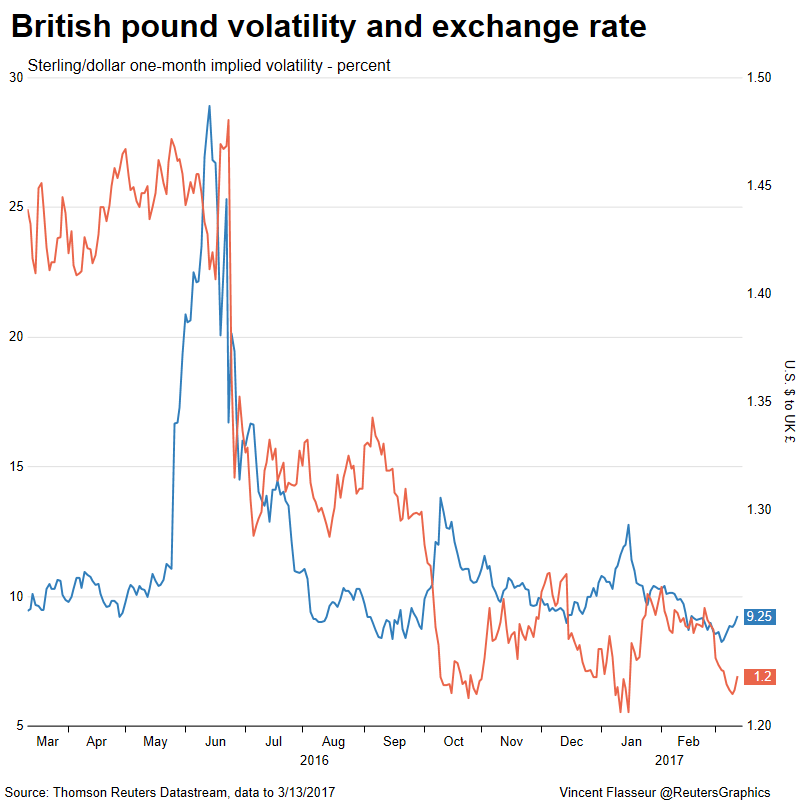The British pound became susceptible to Brexit-induced volatility today as investors were unnerved by Scotland’s fresh call for an independence referendum coinciding with Parliament’s approval of the Article 50 bill. The Scottish National Party’s decision to call a second referendum on Scottish independence from the UK on the same day as the Article 50 bill passed through Parliament, was seen as a deliberate move by the SNP to derail the government’s Brexit plans.
Prior to the SNP’s surprise but not totally unexpected decision to announce plans for a new independence referendum, most analysts had been expecting the Prime Minister, Theresa May to trigger Article 50 within 24 hours of the bill completing its passage through parliament. The Brexit bill had a relatively easy ride as the House of Lords backed down in its attempt to attach two amendments to the government’s bill after MPs voted down both amendments.
It is now thought that May will wait until the end of March to trigger Article 50 and formally start Brexit talks with the EU. The delay to the end of the month means the UK government would avoid the move clashing with several key events taking place during March, including this week’s Dutch elections, next Tuesday’s vote in the Scottish Parliament to request a referendum from Westminster, and the EU’s 60th anniversary summit on March 25.
The SNP’s decision to call for a second independence referendum could complicate Theresa May’s already difficult task of having to negotiate a new trade deal for the UK with 27 EU states. However, a request for another referendum was inevitable given that 62% of Scots voted to remain in the EU and May ruled out the UK retaining access to the EU’s single market post-Brexit.
Sterling fell sharply today following yesterday’s developments as the Scottish referendum adds a new layer of uncertainty for the UK’s future path, while the Brexit bill clears the last hurdle for the UK to initiate the process of leaving the EU. The pound dropped to an 8-week low of 1.2108 dollars earlier today, though it remains close to the past week’s trading range. Also, today’s fall looks exaggerated given the strong gains made on Monday when the pound rallied to a one-week high of 1.2250 dollars.

The perceived market risk of a possible split of Scotland from the rest of the UK appears to be quite low as the SNP is unlikely to get approval to hold the referendum as early as the favored date of autumn 2018. This is because while it would be difficult for the UK government to block the referendum, it is expected to push the timing of such a referendum until after the Brexit negotiations have concluded.
Another potential risk is the possibility of Northern Ireland following Scotland and holding a referendum of its own for leaving the UK to unify with the Republic of Ireland. The province’s largest Irish nationalist party, Sinn Fein, has already said it wants to hold such a vote “as soon as possible” as Brexit threatens to create a hard border between north and south.
But for now, the immediate market concern is what negotiating positions the UK and the EU will adopt once May triggers Article 50. Germany’s chancellor, Angela Merkel, told reports recently that the EU has made contingency plans to respond to May’s Brexit notice within 48 hours, with a special EU summit likely to be held on April 6. One of the first issues that would have to be resolved once talks start is Britain’s exit bill from the EU as the UK would probably have to meet all of its prior spending commitments before leaving the bloc.
A positive start to the Brexit talks would send the right signals to the markets, but with a long road to go before the negotiations concluded, it looks like there will be more volatility ahead for sterling. Despite the uncertainties however, many investors see the pound as being undervalued at the current exchange rate and see only limited scope for further falls. Meanwhile, developments in Europe could also affect how low the pound would go. In particular, a negative outcome at the French election would add downside pressure on the euro and provide some relief for the pound.
Forex trading and trading in other leveraged products involves a significant level of risk and is not suitable for all investors.
Recommended Content
Editors’ Picks
EUR/USD edges lower toward 1.0700 post-US PCE

EUR/USD stays under modest bearish pressure but manages to hold above 1.0700 in the American session on Friday. The US Dollar (USD) gathers strength against its rivals after the stronger-than-forecast PCE inflation data, not allowing the pair to gain traction.
GBP/USD retreats to 1.2500 on renewed USD strength

GBP/USD lost its traction and turned negative on the day near 1.2500. Following the stronger-than-expected PCE inflation readings from the US, the USD stays resilient and makes it difficult for the pair to gather recovery momentum.
Gold struggles to hold above $2,350 following US inflation

Gold turned south and declined toward $2,340, erasing a large portion of its daily gains, as the USD benefited from PCE inflation data. The benchmark 10-year US yield, however, stays in negative territory and helps XAU/USD limit its losses.
Bitcoin Weekly Forecast: BTC’s next breakout could propel it to $80,000 Premium

Bitcoin’s recent price consolidation could be nearing its end as technical indicators and on-chain metrics suggest a potential upward breakout. However, this move would not be straightforward and could punish impatient investors.
Week ahead – Hawkish risk as Fed and NFP on tap, Eurozone data eyed too

Fed meets on Wednesday as US inflation stays elevated. Will Friday’s jobs report bring relief or more angst for the markets? Eurozone flash GDP and CPI numbers in focus for the Euro.